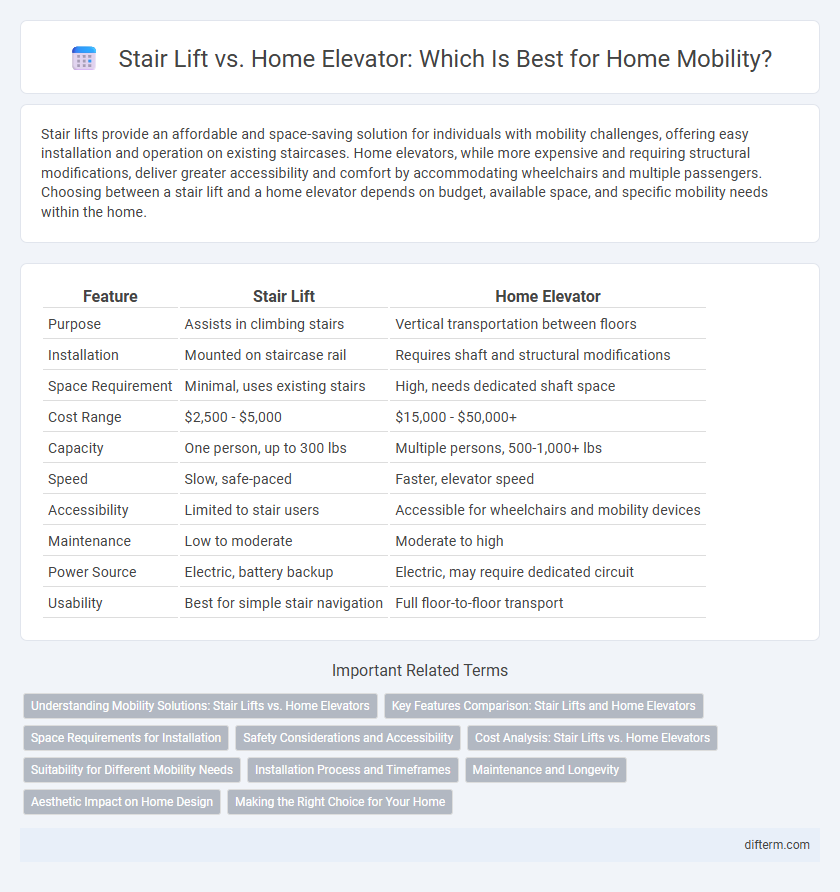Stair lifts provide an affordable and space-saving solution for individuals with mobility challenges, offering easy installation and operation on existing staircases. Home elevators, while more expensive and requiring structural modifications, deliver greater accessibility and comfort by accommodating wheelchairs and multiple passengers. Choosing between a stair lift and a home elevator depends on budget, available space, and specific mobility needs within the home.
Table of Comparison
| Feature | Stair Lift | Home Elevator |
|---|---|---|
| Purpose | Assists in climbing stairs | Vertical transportation between floors |
| Installation | Mounted on staircase rail | Requires shaft and structural modifications |
| Space Requirement | Minimal, uses existing stairs | High, needs dedicated shaft space |
| Cost Range | $2,500 - $5,000 | $15,000 - $50,000+ |
| Capacity | One person, up to 300 lbs | Multiple persons, 500-1,000+ lbs |
| Speed | Slow, safe-paced | Faster, elevator speed |
| Accessibility | Limited to stair users | Accessible for wheelchairs and mobility devices |
| Maintenance | Low to moderate | Moderate to high |
| Power Source | Electric, battery backup | Electric, may require dedicated circuit |
| Usability | Best for simple stair navigation | Full floor-to-floor transport |
Understanding Mobility Solutions: Stair Lifts vs. Home Elevators
Stair lifts provide an affordable, space-saving solution that allows users to traverse stairs safely, ideal for homes with limited space or budget constraints. Home elevators offer a more comprehensive mobility solution, accommodating wheelchairs and multiple passengers, but require significant structural modifications and higher investment. Both options enhance independence and accessibility, with the choice depending on individual mobility needs, home layout, and financial considerations.
Key Features Comparison: Stair Lifts and Home Elevators
Stair lifts feature a motorized chair that travels along a rail mounted on the stairs, ideal for narrow staircases and limited space, offering ease of installation and affordability. Home elevators provide vertical transportation through a cabin enclosed within a shaft, offering higher weight capacity, customization options, and accessibility for wheelchairs, making them suitable for multi-story homes. Both solutions vary in speed, maintenance requirements, and installation complexity, with stair lifts being less invasive and home elevators delivering greater convenience for full mobility needs.
Space Requirements for Installation
Stair lifts require minimal space, typically needing only a narrow rail along the staircase, making them suitable for homes with limited room. Home elevators demand a dedicated shaft or room, which can significantly reduce usable living space and involves more extensive structural modifications. Evaluating space constraints ensures the mobility solution aligns with the home's layout and occupant needs.
Safety Considerations and Accessibility
Stair lifts offer a compact solution with secure seat belts and obstruction sensors, ensuring user safety on narrow staircases. Home elevators provide broader accessibility, accommodating wheelchairs and walkers with smooth, enclosed cabins and emergency communication systems. Selecting between these options depends on the user's mobility needs, spatial constraints, and the level of safety features required for daily use.
Cost Analysis: Stair Lifts vs. Home Elevators
Stair lifts typically range from $3,000 to $5,000, offering a cost-effective solution for single or straight staircases, while home elevators can exceed $20,000 due to complex installation and customization. Maintenance costs for stair lifts are generally lower, averaging $100 to $300 per year, compared to home elevators that may require $500 to $1,000 annually. Evaluating long-term expenses and property modifications is crucial in determining the most economical choice between stair lifts and home elevators.
Suitability for Different Mobility Needs
Stair lifts provide a practical solution for individuals with limited mobility who can still manage some stair navigation, offering safe and affordable access to upper floors in narrow or curved staircases. Home elevators deliver a more versatile option for users with severe mobility impairments or wheelchair dependency, allowing effortless vertical transportation with greater comfort, space, and design customization. Evaluating specific mobility challenges, home layout, and budget constraints is essential to select the most suitable accessibility device for improved independence and safety.
Installation Process and Timeframes
Stair lifts typically install in a few hours, requiring minimal structural modifications and often fitting directly onto existing staircases. Home elevators demand a more complex installation process involving construction work, electrical wiring, and compliance with building codes, which can extend the timeframe to several weeks. The choice between a stair lift and a home elevator hinges on the urgency of installation and the scope of home alterations desired.
Maintenance and Longevity
Stair lifts require regular maintenance such as battery checks and track cleaning to ensure smooth operation, typically lasting 10-15 years with proper care. Home elevators, built with more complex mechanical and electrical systems, demand professional servicing but offer a longer lifespan of 20-30 years. Choosing between the two depends on the homeowner's willingness to invest in ongoing maintenance and desired durability.
Aesthetic Impact on Home Design
Stair lifts typically have a minimal footprint but can disrupt the visual flow of staircases with exposed tracks and mechanical components. Home elevators offer a sleek, integrated design that can blend seamlessly with modern interiors and enhance property value through their architectural presence. Choosing a home elevator often results in a cleaner aesthetic and a more harmonious home environment compared to the utilitarian appearance of stair lifts.
Making the Right Choice for Your Home
Choosing between a stair lift and a home elevator depends on factors such as space availability, budget, and mobility needs. Stair lifts are cost-effective, ideal for narrow or curved staircases, and require minimal installation space, while home elevators offer greater accessibility, smoother operation, and increased home value but need more extensive renovations. Assessing long-term benefits, personal mobility requirements, and home layout ensures the most suitable mobility solution for safe and convenient access.
stair lift vs home elevator Infographic

 difterm.com
difterm.com